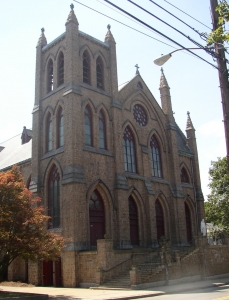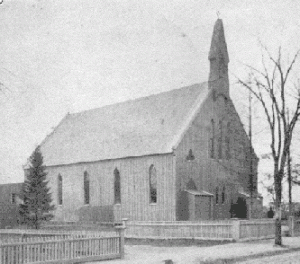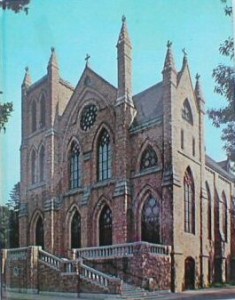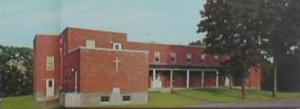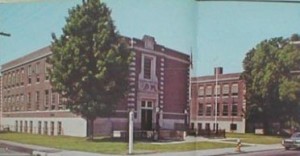The history of St. Mary’s Parish goes back much farther than 1866. Town history records the presence in 1758 of 11 Catholics – “Acadians” – who were allowed harbor in town as “French Neutrals.” They were indeed homeless, because Acadia, or Nova Scotia, had become a British Colony and many Frenchmen had been deported by the British because of grave doubts regarding their loyalty to King George II. There was no Catholic Church in Dedham where these Acadians could worship, and no priest to offer them solace, but the town recognized their religion and gave them refuge.
For a more comprehensive history click here
The First Mass in Dedham
In the years that followed, Catholics were few in Dedham. Indeed, prior to 1843, the few Catholics in our town walked sixteen miles – eight miles to Roxbury and eight miles back – in order to attend Mass. The first Mass in town was celebrated in 1843 by Father James Strain in Daniel Slattery’s home. There were eight Catholics present. Every Sunday, for three years, Daniel Slattery would send his young brother-inlaw, John Dagget, a boy of seventeen, to drive Father Strain from Waltham to Dedham and back. Daniel Slattery’s house was subsequently removed and Memorial Hall was erected on the site:
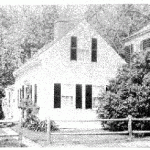 The house of Daniel Slattery where the first Mass in Dedham was said
The house of Daniel Slattery where the first Mass in Dedham was said
Early Growth
In 1846, Dedham became part of the Mission of St. Joseph’s in Roxbury, and Father Patrick O’Beirne came to Dedham regularly to celebrate Mass on Sunday. There was no church, and Father O’Beirne used Temperance Hall for eleven years. It was in this same Hall that the disturbing issues before the nation were dramatized by a tall, modest speaker whose name was not yet famous – Abraham Lincoln. At this period many Irish were fleeing years of agricultural famine in their beloved Isle, and were emigrating to the United States. Substantial numbers settled in and around Dedham.
The First Church
This increasing Catholic population enabled Father O’Beirne to build the first St. Mary’s Church in Dedham in 1857.
Every Sunday Father O’Beirne said Mass, and during the week he would come to Dedham to meet the needs of his congregation. But the issues of which Abraham Lincoln had spoken in Temperance Hall were now tearing the nation apart. The Civil War was making its effects felt in Dedham. The able-bodied men of St. Mary’s readily answered the nation’s call. “No church in Dedham lost so many men in proportion to their numbers,” says the Dedham Transcript in its edition celebrating the 325th Anniversary of our town. And so the “newcomers” of the past two decades from Ireland became indeed a part of Dedham. Now their patriotism was proved, for it was written in blood. And now at last their Catholic religion came to be regarded with a degree of tolerance not known before.
The First Rectory of St. Mary’s
In 1867 Father Brennan purchased a plot of land with a house on High Street, converting the home into a Rectory. It soon became evident to Father Brennan that he would need a new Church, for Catholics were still arriving in great numbers from Ireland. Soon his duties became so arduous that he was given an assistant Pastor, the Rev. John D. Tierney. Today it is worthy of note that Father Tierney was unsalaried, though he had the distinction of being St. Mary’s first Curate. A year later he was appointed Rector of the Church of the Holy Family, Rockland. As time went on, Father Brennan found his duties becoming more and more demanding. He was also responsible for the Mission in Norwood, which required much attention. It is said that in the attempt to save time he would often send the church collections, uncounted, to the bank. He hoped, of course, that the bank would count the money and credit him with the total. After eleven years of faithful service, Father Brennan resigned in 1877, to be succeeded by Father Denis J. Donovan, who had been assistant Pastor for a year. Father Donovan baptized one of the sons of the Parish who was to become a Prelate of the Church, Monsignor Charles A. Finn.
The Cornerstone of St. Mary’s Church
In October 1880, in the face of financial difficulties, with unswerving faith, Father Johnson invited Archbishop John J. Williams to lay the cornerstone of our present Church. Priests from all the neighboring parishes attended the ceremony. A special train was run from Boston, bringing a large number of friends and a choir of 100 singers. Thousands witnessed the ceremony. Nearly all the local officials of Dedham and business men attended – this universal recognition from the town being a great tribute to the warmth and friendliness of Father Johnson. As many of these officials knew, the Master of Ceremonies, Rev. Theodore A. Metcalf, was a descendant of Michael Metcalf, one of the original settlers who founded the “plantation” of Dedham in 1635. In this well attended ceremony there was also proof that Dedham had never adapted the harsh and narrow measures instituted in Boston and Charleston against those of different religious views. It was in 1880 also, at a Town meeting, that Dedham officials re- Rev. John H. Fleming, Pastor cognized the increasing number of Catholics by reserving a part of Brook- 1890-1923. dale Cemetery for deceased members of our Faith. During his pastorate, Father Johnson made grateful use of this offer.
The Basement Church
The building of the Church exterior proceeded rapidly, though lack of funds slowed the furnishing and decoration of the whole interior. Father Johnson had decided to erect a “Cathedral” but cathedrals cost money, and take time for their completion. So the basement was finished first, then furnished, and handsomely decorated. In the meantime the old church had been destroyed, and it was necessary to say Mass in the basement. Indeed, for many years the basement proved to be a serviceable church. The Main Altar, large and substantial, was constructed of marble. The two smaller altars were of wood, delicately carved, and the statues were works of art. The need for money became greater than ever. It was at this time, in 1881, that Mr. A. W. Nickerson, a Protestant whose generosity had endeared him to St. Mary’s, paid off the standing debt of the old church and contributed $10,000.00 toward the erection of the new church. Another Protestant, Mr. John R. Bullard, donated the Dedham granite of which the church is constructed. In the “History of the Aschdiocese of Boston,” (1895), it is written that “The benevolence of these two Protestant gentlemen is worthy of note, and the local Catholics hope their names may long live in the memory of the future parishioners of St. Mary’s . . For financial reasons, when the exterior of the Upper Church was completed, its interior was left unfurnished, though it was used on rare occasions for Fairs and various other important gatherings.
The Dedication of St. Mary’s Church
On September 9, 1900, St. Mary’s Church was dedicated by Archbishop Williams of Boston. In his dedication sermon Archbishop Williams said:
“Today, my beloved brethren, like unto Solomon on the occasion of the dedication of the Great Temple of Jerusalem, your zealous Pastor proclaims that you have built a house in God’s name . . . To you has been reserved the privilege of offering to God a house as worthy of His Name as this beautiful structure in which we are assembled this morning.”
Father Fleming also purchased land for a Cemetery in West Roxbury, preferring that Catholics be buried in a lot of their own. For up to this time Catholics had been buried in Brookdale Cemetery, in that portion of the ground which had been reserved in 1880 for deceased Catholics.
St. Mary’s Today
The parish maintained the majority of its properties throughout the later half of the 20th century. With the emergence of the Life Teen program in 1997, the basement of the school building was converted into a central gathering place. In 2010, the school building was razed and the lot developed into a needed parking lot. This allowed for a complete renovation of the Lower Church, dividing the area into two spaces: One half, renamed Mary Hall, now serves as the parish hall, while the other half serves as the Life House for the Life Teen program.
St. Mary’s Church, Convent & School
The convent, where the Parish Office is now located
The school building, completed in 1958

